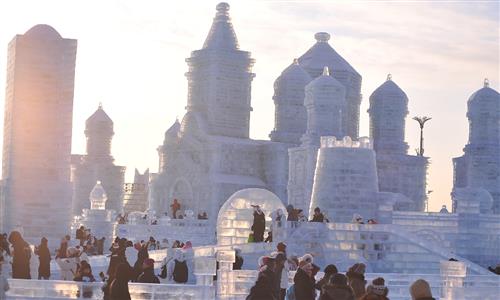Snow and ice tourism festivals open nationwide, unleashing ‘hot effect’ of consumption

An aerial drone photo taken on Dec. 9, 2024 shows the construction site of the Harbin Ice-Snow World in Harbin, northeast China's Heilongjiang Province. (Photo: Xinhua)
One of the latest places to launch a snow and ice-related festival or event, Shimian county in Southwest China's Sichuan Province will kick off a snow and ice tourism season combining hot spring tours on Monday, after many such events nationwide have already welcomed tourists.
The iconic Harbin Ice and Snow World officially opened to tourists on Saturday, with all tickets for adults for the opening day and the following week sold out across multiple travel platforms, according to media reports.
With ski resorts and winter festivals opening one after another nationwide, from the end of November, the sales and search volume of ice and snow tourism products continued to increase, according to statistics sent from domestic online travel agency Trip.com to the Global Times on Saturday.
In the past week, the search volume for "skiing" on Trip.com increased by 50 percent compared with the previous week, the agency said.
Snow and ice tourism activities are booming across China. Harbin in Northeast China's Heilongjiang Province continued to be the top destination for winter tourism, according to data from several online travel agencies.
In the past month, the number of tickets booked at domestic ski resorts has increased by nearly 20 percent compared with last year. Ski resorts in Beijing, North China's Zhangjiakou, Northeast China's Jilin and Changchun, and Northwest China's Altay have the highest number of bookings, according to Trip.com.
Due to technological advances, while ice and snow tourism and sports consumption continues to heat up, winter activities, which were once regarded as "exclusive" to the northern part of China due to its natural conditions, have been spreading in the southern China, where the average winter temperature is above freezing.
For example, an indoor ski resort, which opened on November 8 in Wuhan, Central China's Hubei Province witnessed ticket sales exceeding 20 million yuan ($2.7 million) in one month, local media reported, citing a person in charge.
In Shenzhen, South China's Guangdong Province, Karoo Ice Snow, an indoor winter activity complex, drew tourists from cities in the Guangdong-Hong Kong-Macao Greater Bay Area with various snow and ice entertainment facilities. The venue has received nearly 350,000 tourists since its opening in March 2023, according to media reports.
Among users booking ski hotels during the 2024-25 snow season, nine out of the top 10 tourist sources are located in the southern part of China, namely Shanghai, Shenzhen and Guangzhou in South China, Hangzhou, Suzhou and Nanjing in East China, as well as Changsha, Huangshi and Wuhan in Central China.
Due to China's abundant natural resources and technological advantages, the winter economy has broad space for development. Some provinces in southern China have indoor ski resorts to meet local needs, Jiang Yiyi, a vice dean of the School of Leisure Sports and Tourism at Beijing Sport University, told the Global Times on Sunday.
"Ice and snow sports, which used to be a niche tourism market, has begun to gain popularity. The continuous expansion of the winter tourism market is playing an increasingly important role in driving consumption," Jiang said.
In November, China issued guidelines to promote the development of the winter economy, aiming to promote it as a new growth point, with the goal of reaching an economic scale of 1.2 trillion yuan by 2027 and 1.5 trillion yuan by 2030, according to the guidelines issued by the General Office of the State Council.



